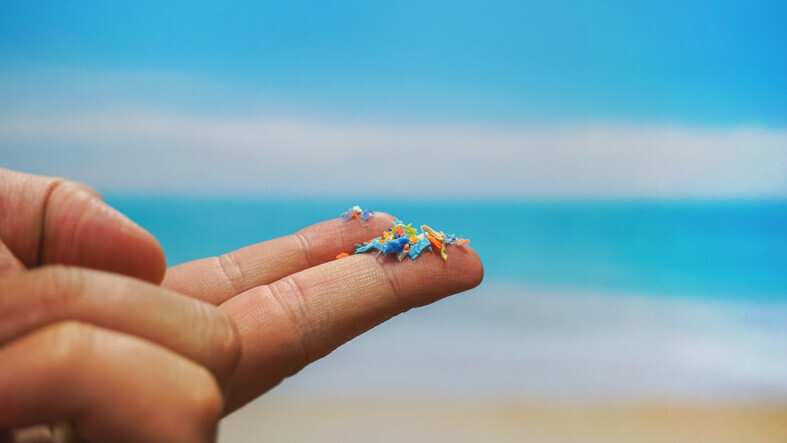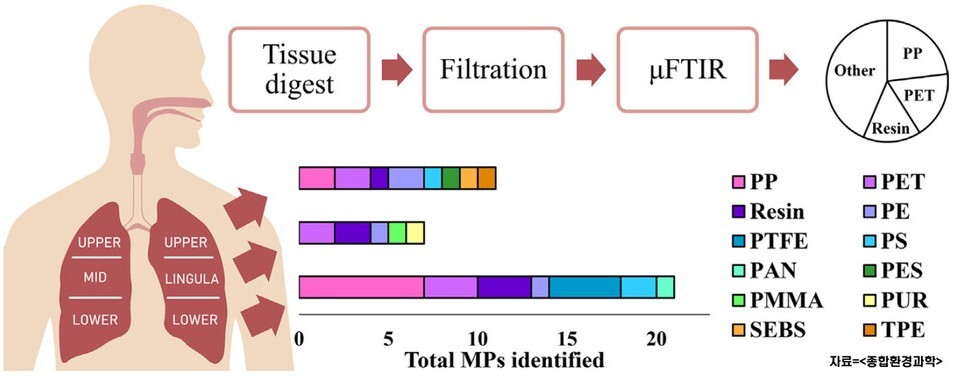hankyoreh
Links to other country sites 다른 나라 사이트 링크
Plastics from food packaging are burrowing into our lungs, blood

Microplastics are being discovered everywhere — from the North and South Poles to the deep ocean floor. They were even found in the lungs and blood of living humans recently. Research indicates that we each consume 5 grams of microplastics a week through our gastrointestinal tract.
A team of researchers at Hull York Medical School in the UK announced Thursday that it had discovered microplastics in live human lungs in the most robust study of its kind. The team’s study will be published in the scientific journal Science of The Total Environment.
The team used samples of healthy lung tissue obtained during lung transplant surgeries for lung cancer or pulmonary emphysema patients for its research. Researchers analyzed particles 0.003 millimeters in size obtained from their samples, identifying different types of plastic by using spectroscopes. An analysis of tissue samples obtained from 13 patients showed 11 samples to have microplastics in their lungs.
Microplastics are defined as plastic particles smaller in size than 5 millimeters. The 11 samples that contained microplastics yielded 1.42 pieces of microplastic per 1 gram of tissue on average.

Of the microplastics identified, 23% were polypropylene (PP) used for packaging and piping, 18% were polyethylene terephthalate (PET) frequently used to make water bottles, and 15% were resin. While the upper part of the lung and the middle part of the organ yielded 0.80 and 0.41 pieces of microplastics per 1 gram of tissue, respectively, the highest number of microplastics was found in the lower part of the lung, which yielded 3.12 pieces of microplastics per 1 gram of tissue.
“We did not expect to find the highest number of particles in the lower regions of the lungs, or particles of the sizes we found. It is surprising as the airways are smaller in the lower parts of the lungs and we would have expected particles of these sizes to be filtered out or trapped before getting this deep,” said Laura Sadofsky of Hull York Medical School, a senior author of the study.
Microplastics were also detected in the lung samples of 13 out of 20 people autopsied in Brazil last year.

Microplastics were detected in human blood for the first time last month by a research team from Vrije Universiteit Amsterdam, in the Netherlands. Their analysis found microplastics in the blood of 17 of 22 adult blood donors. Their paper was published in the scholarly journal Environment International.
“The [microplastic] particles are [in the blood] and are transported throughout the body,” Dick Vethaak, a professor at Vrije Universiteit Amsterdam, told the Guardian.
Paraphrasing Vethaak, the Guardian said that “previous work had shown that microplastics were 10 times higher in the faeces of babies compared with adults and that babies fed with plastic bottles are swallowing millions of microplastic particles a day.”

According to researchers from the Medical University of Vienna, an average of 5g of plastic particles enter each person’s gastrointestinal tract every week. That’s about the weight of a credit card.
“Whether ingested micro- and nanoplastics pose a health risk is being investigated in numerous studies but is largely unknown to date,” the researchers explained.
In a lab experiment performed by researchers at the Medical University of Vienna, microplastics and nanoplastics ingested through the gastrointestinal tract were found to change the formation of microbiomes inside the intestine in ways that affect the incidence of metabolic diseases including diabetes, obesity and chronic liver disease.
The research team’s review of the current state of research was published in the scientific journal Exposure and Health.
Microplastics, which measure 0.001-5 millimeters, are partially visible to the eye, unlike nanoplastics, which measure less than 0.0001 millimeters. Plastic particles enter the human body through the consumption of marine life and sea salt.
“According to a study, anyone who drinks the recommended 1.5 to two liters of water a day from plastic bottles ingests around 90,000 plastic particles per year in this way alone. However, those who choose tap water can [. . .] reduce the amount ingested to 40,000 plastic particles,” the researchers said.
By Lee Keun-young, staff reporter
Please direct questions or comments to [english@hani.co.kr]

Editorial・opinion
![[Guest essay] Maybe Korea’s rapid population decline is an opportunity, not a crisis [Guest essay] Maybe Korea’s rapid population decline is an opportunity, not a crisis](https://flexible.img.hani.co.kr/flexible/normal/500/300/imgdb/original/2024/0430/9417144634983596.jpg) [Guest essay] Maybe Korea’s rapid population decline is an opportunity, not a crisis
[Guest essay] Maybe Korea’s rapid population decline is an opportunity, not a crisis![[Column] Can Yoon steer diplomacy with Russia, China back on track? [Column] Can Yoon steer diplomacy with Russia, China back on track?](https://flexible.img.hani.co.kr/flexible/normal/500/300/imgdb/original/2024/0430/1617144616798244.jpg) [Column] Can Yoon steer diplomacy with Russia, China back on track?
[Column] Can Yoon steer diplomacy with Russia, China back on track?- [Column] Season 2 of special prosecutor probe may be coming to Korea soon
- [Column] Park Geun-hye déjà vu in Yoon Suk-yeol
- [Editorial] New weight of N. Korea’s nuclear threats makes dialogue all the more urgent
- [Guest essay] The real reason Korea’s new right wants to dub Rhee a founding father
- [Column] ‘Choson’: Is it time we start referring to N. Korea in its own terms?
- [Editorial] Japan’s rewriting of history with Korea has gone too far
- [Column] The president’s questionable capacity for dialogue
- [Column] Are chaebol firms just pizza pies for families to divvy up as they please?
Most viewed articles
- 1Under conservative chief, Korea’s TRC brands teenage wartime massacre victims as traitors
- 2[Guest essay] Maybe Korea’s rapid population decline is an opportunity, not a crisis
- 3Dermatology, plastic surgery drove record medical tourism to Korea in 2023
- 4Value of Korean won down 7.3% in 2024, a steeper plunge than during 2008 crisis
- 5Thursday to mark start of resignations by senior doctors amid standoff with government
- 6Two factors that’ll decide if Korea’s economy keeps on its upward trend
- 7[Column] Can Yoon steer diplomacy with Russia, China back on track?
- 8Months and months of overdue wages are pushing migrant workers in Korea into debt
- 9First meeting between Yoon, Lee in 2 years ends without compromise or agreement
- 10Why Kim Jong-un is scrapping the term ‘Day of the Sun’ and toning down fanfare for predecessors